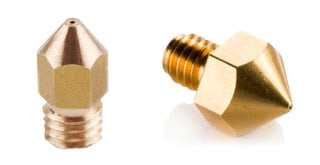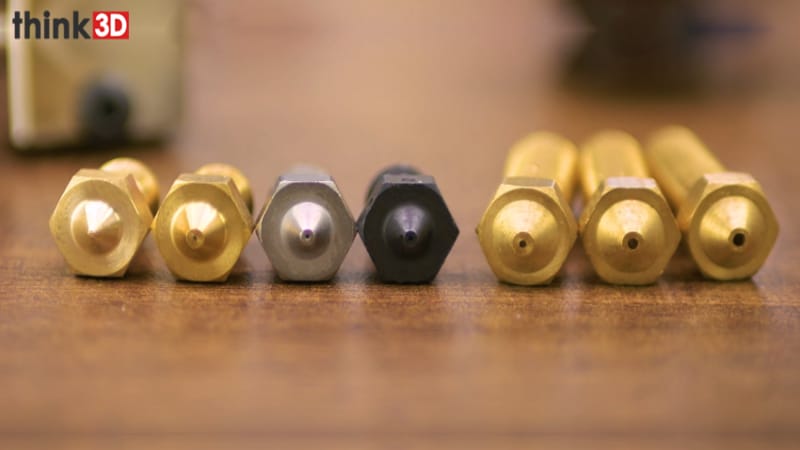3D Printer nozzle is one of the most important components of FDM 3D Printers. This is the last piece of item that the material touches before it gets extruded onto the build plate. Previously there was only one type of nozzle – Brass Nozzle (0.4mm diameter). Due to excellent thermal conductivity properties of brass and low melting point temperature & non-abrasive nature of ABS, PLA material, this nozzle was more than sufficient for FDM 3D Printing needs. But over time the application needs of FDM 3D Printing technology grew manifold and so are the needs to come up with different nozzle that can withstand higher temperatures and abrasive materials. In this article we shall look at various such nozzles in detail. Nozzle can be generally classified as per below
(a) Filament Diameter – 1.75mm (or) 2.85mm. There are only 2 standard filament diameters available.
(b) Nozzle Material – Various new types of nozzles are being launched regularly. We have brass nozzle, stainless steel nozzle, hardened steel nozzle, titanium nozzle and many more new types of nozzles are being launched regularly. Here is a quick overview of different nozzle materials
- Brass – Brass is the most common metal used for nozzles. Brass can be used to print PLA, ABS, PETG, Nylon, TPE, TPU, PC and most any other non-abrasive materials. Brass has excellent thermal conductive properties and are good for printing standard thermoplastics like ABS, PLA but brass isn’t good for abrasive filaments.
- Stainless Steel – A step above brass, nozzles made from stainless steel are good if you want to print a wide range of types of filament, including abrasives. Also stainless steel nozzles are recommended for medical applications.
- Hardened steel – If you want to print purely abrasive materials, hardened steel nozzles are what you want.
- Specialty materials – Other materials, like Tungsten and Ruby, have been used to make harder nozzles that can stand up to constant abrasion. These are for printing exclusively abrasive materials, and typically cost more than the other options.
(c) Nozzle Diameter – Previously there was only one standard diameter – 0.4 mm. But over time various new diameter nozzles are entering the market – 0.25mm, 0.6mm, 0.8mm
(d) Nozzle Length – We have both longer nozzles and shorter nozzles. Longer nozzles are easy to clean due to proper airflow whereas shorter nozzles reduce heat loss, help in better transmission of heat & also reduce the positioning error. Also, the material consumed will be less to manufacture shorter nozzles. Now a days, many 3D Printer manufacturers are opting for shorter nozzles for their machines.
(e) Nozzle Outside Shape – In general, we have two types of nozzle shapes in the market – (a) Pointed Nozzles (b) Flat Head Nozzles. The latest Ultimaker 3D Printer comes with pointed nozzle. The major advantage of pointed nozzle is reduction of unwanted heat transfer to already deposited material. One important criteria for quality 3D Prints is to ensure the material cools down rapidly once deposited. But with flat-head nozzle, we again heat the material unwanted during the deposition of new layer. It becomes very clear when you try to print pyramids / cones / objects with pointed ends.
But the pointed nozzles require greater positioning accuracy and any wrong positioning may scratch the glass plate or deposited material easily. So, for more sturdiness we should opt for flat head nozzle and for better quality we should opt for pointed nozzle.

(f) Nozzle Inside Shape – There is no major limitation on the nozzle inside shape except for not letting thin conduits.
E3D is industry leader for high quality hotends. We supply E3D hotends to our ends. If you wish to purchase a nozzle, feel free to contact us.
